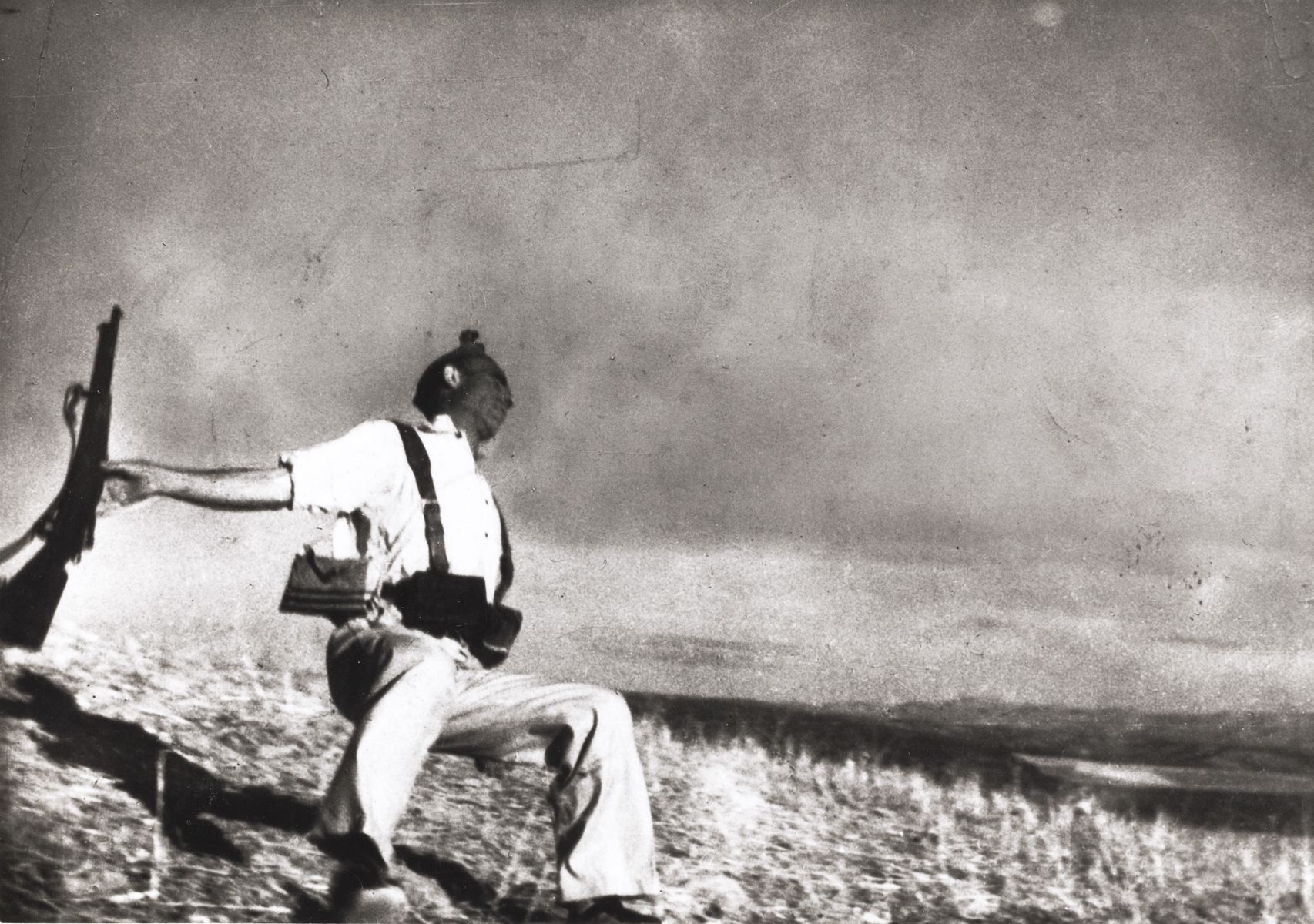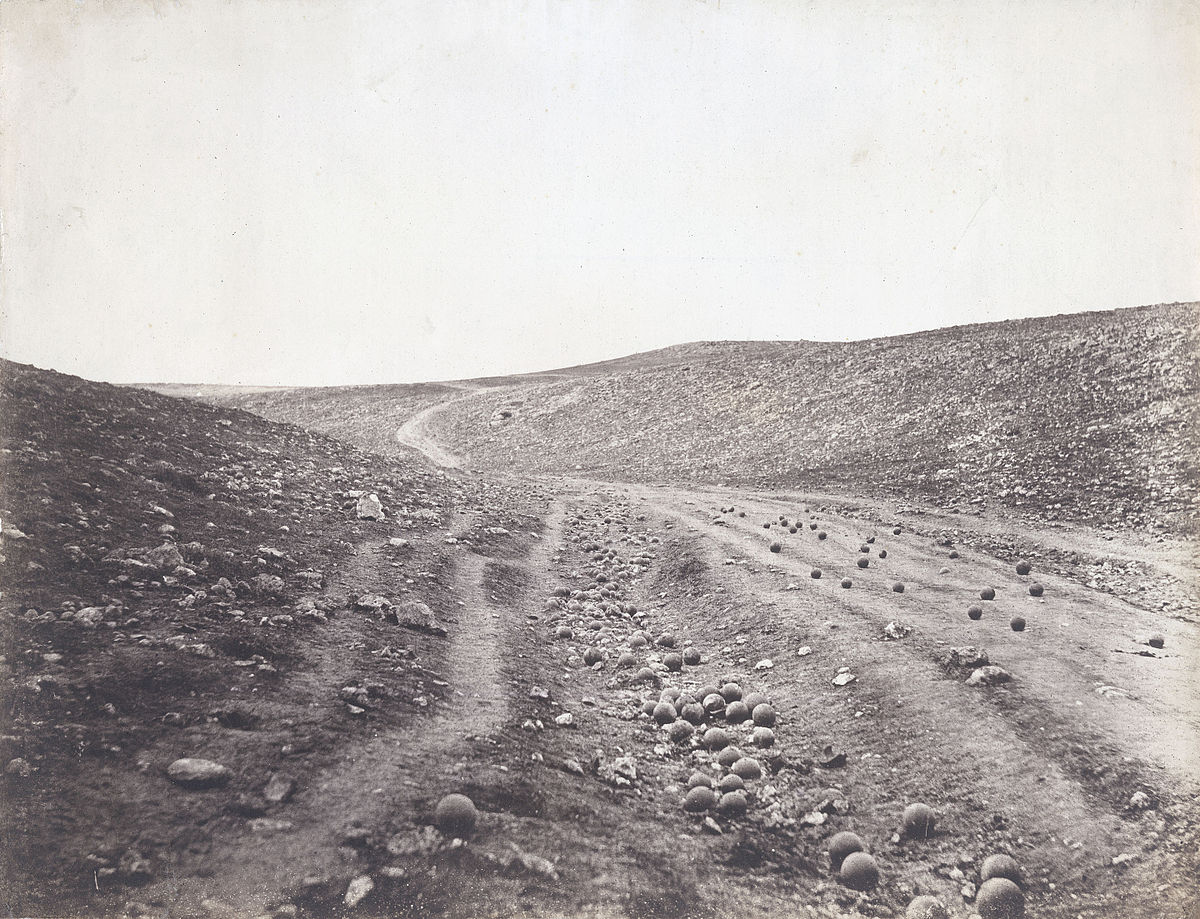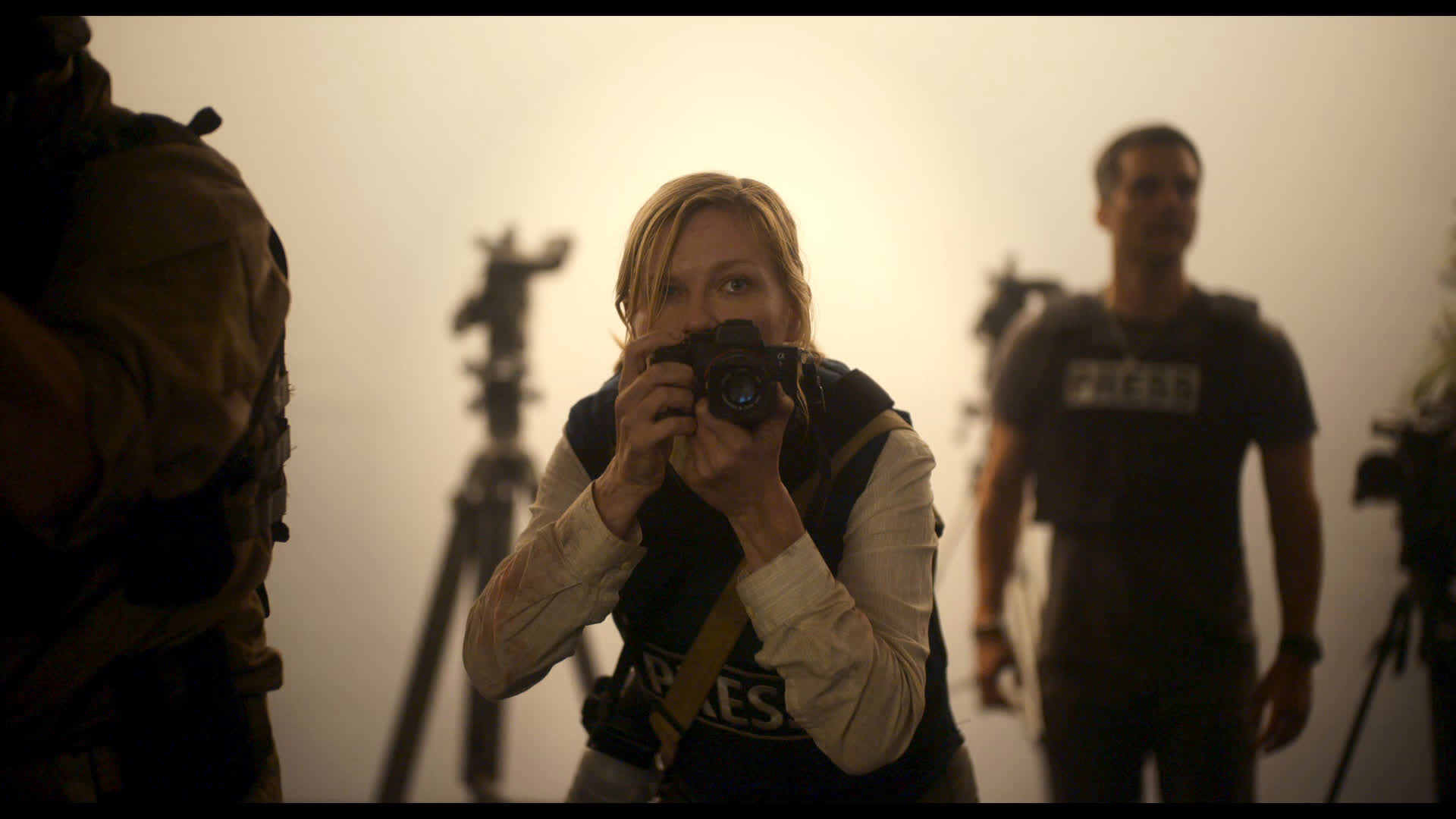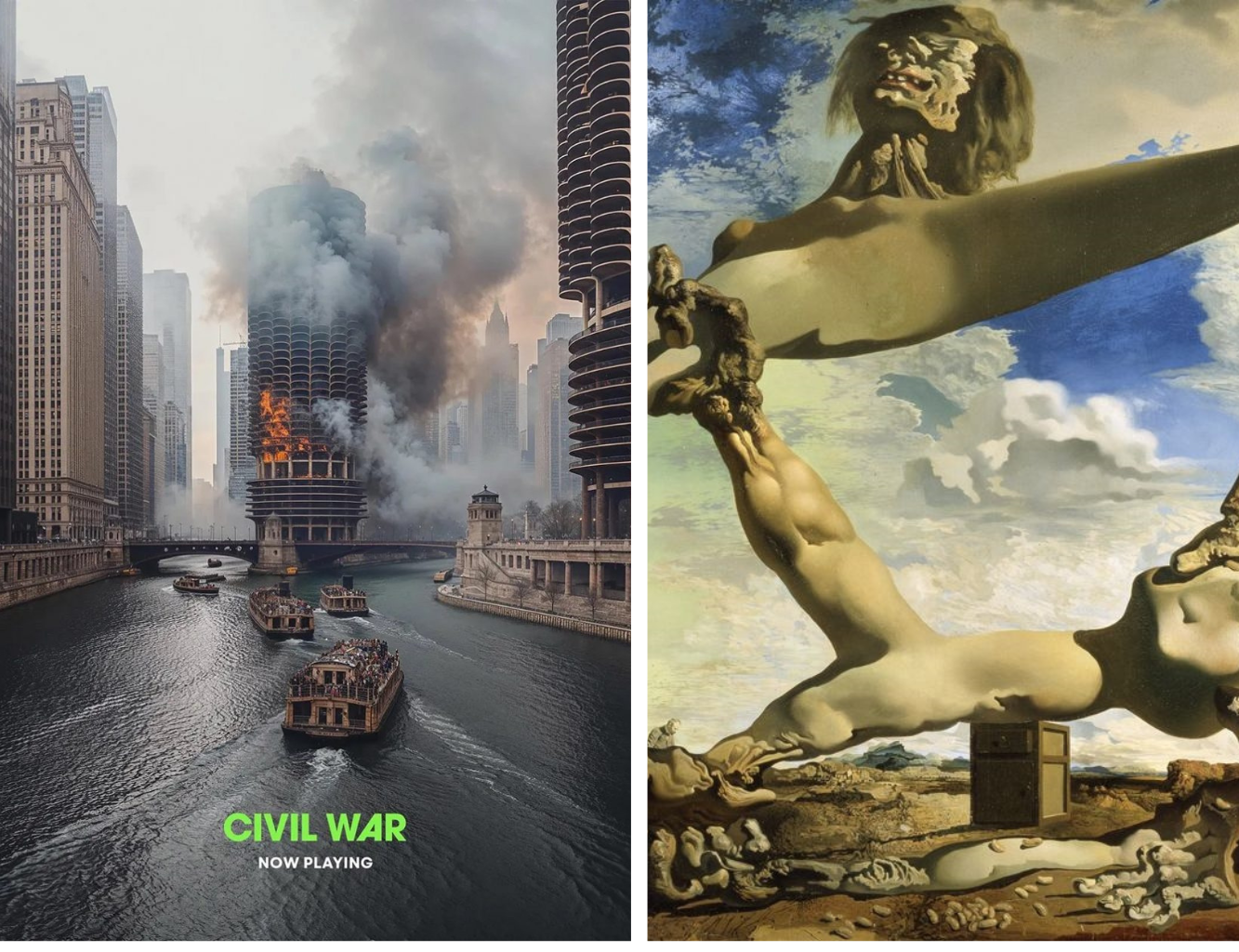The Graveyard of the Eye. Notes on Images of War, Surrounding “Civil War” | The State of Cinema
In this little film by the Straubs, Einleitung, there’s the image of the Communards in their coffins, and that of B-52s bombing. These are of course not neutral images. (…) The non-neutrality of these images is not only that they put us in the presence of something horrible, it is that they show something for which there is no counter-shot, no counter-proof, no other positive image: a photo taken by the Communards or the B-52 seen from the ground, i.e. from the bombed field, and that is to say, an impossible photo.
— Serge Daney, A Tomb for the Eye (Straubian Pedagogy)
The frontline and the fakes: a brief introduction to war photography

Robert Capa, “Falling Soldier”.
In 1936, almost 20 years before a mine in Vietnam was to cut his life short, Hungarian photographer Robert Capa (born Endre Friedmann) caught what was to become one of the definitory images of the Spanish Civil War: The Falling Soldier (or Loyalist Militiaman at the Moment of Death, Cerro Muriano, September 5, 1936) – surpassed in celebrity perhaps only by two paintings made by two of the most famous Spanish artists of all time, Pablo Picasso and Salvador Dali; Guernica, respectively Soft Construction with Boiled Beans (Premonition of Civil War). Beyond its remarkable composition – according to the golden rule, the subject is placed in one of the frame’s most important focal points; its stark dynamism, the dramatic posture of the man that contacts with the austere background of the field –, Capa’s photo also enters history as one of the first seminal images to capture the very moment of death (thus contrasting with the already-established tradition of funeral photography, which usually represented dead bodies that were ready to be interred; also worth mentioning is the fact that the very first photograph of a public execution had only been shot eight years prior, in New York). Or, at least, that was the myth surrounding the image that was sustained by its author: because The Falling Soldier is also one of the most famous snapshots to have borne the accusation of being staged. Falsifying a photograph has several primordial motivations – not just the manipulation of its factual content, or what one may call its “truth” (thus, falsifying a statement about reality), it also very much regards aesthetics: that is, the extraction of a precise and memorable visual result.
Capa, together with names such as Gerda Taro (his partner and – some suspect – the true author behind The Falling Soldier), David Seymour, Margaret Bourke-White, Lee Miller, or Joe Rosenthal were some of the first photographers to lay the groundwork for the professionalization of war photography, understood as more than a particular branch within a larger field of work, but also as an occupation wherein a given practitioner may impose themselves as an auteur, bearing a distinctive signature. Because war photography, as a practice, surfaced not long after the wide-spread adoption of photographic technique: almost three decades after Nicéphore Niépce’s first plates, Roger Fenton was dispatched to document the Russo-Turkish war with this new technology (which was also documented by the first important Hungarian-Romanian photographer, Carol Szathmari), becoming the first “official” war photographer in history, in a time when “war painters”, the pre-modern ancestors of his trade, were still sent to the front. As he abhorred the idea of taking snapshots of the dead bodies of combatants, Fenton turned his camera, amongst others, towards the landscape of war: a decision which gave birth to his most famous image, The Valley of the Shadow of Death – which historians consider to be the first important, famous war photograph. (Later photographs of this war, as well as those of the wars fought by the British Empire in East Asia, include the famous photographs of the American Civil War by Robert Gardner.)
The Valley is an image that is symptomatic of an age wherein the exposure time of a photographic plate was so long that the medium was unable to capture dynamic elements, just static ones – and so, human subjects (that are not posing for a photo) are absent: what we see in the image is a valley between two hills that is littered by dozens, even hundreds of cannonballs. We are still within the terrain of suggestion – the sudden death that Capa (allegedly) shot is not just a mere technical impossibility at this point, but also an intangible subject, which must be deduced based on its traces: the cannonball is also a signifier of its flight through the air, and thus, of the reasons behind its launch. Even so, The Valley is also overshadowed by the same suspicion of falsity that plagues The Falling Soldier: because there are two extant versions of it, which show different positions of the cannonballs, thus inviting the suspicion (or verdict, in the case of Susan Sontag) that “objective reality” had been manipulated. Errol Morris dedicated fascinating research to this image, which was included in his 2011 anthology Believing is Seeing, traveling to Crimea to discover the truth behind the photograph, identifying both its topographic location, as well as the light, shadows, and time of day at which it was shot, the effects of the particular photosensitive emulsion that was used, the camera’s orientation within space and the duration of exposure, amongst countless other details. (The conclusion? Like all good conclusions, an uncertain one – yet fascinatingly complex and compelling in its architecture, so I must invite you to read it in full.)

Roger Fenton, „The Valley of the Shadow of Death.”
Counter-images and images-counter(feit)
Some photos have such a strong renown that the mere act of evoking their titles leads to an almost instantaneous reproduction within the reader’s memory: The Afghan Girl. Tank man. Guerrillero Heroico. The Terror of War (or Napalm Girl). The Burning Monk (or The Suicide of Thich Quang Duc). The Eagle and the Girl. Execution in Saigon. Raising the Flag Over Iwo Jima. Inside Buchenwald. Every one of these images likely came up in your mind as you read these lines. One of the last photographs to become essential parts of our contemporary visual imaginary was published in 2015, at the height of the Syrian war refugee crisis: The Death of Alan Kurdi – a series of photos of a small baby boy, wearing a red T-shirt and navy blue shorts, flying face down into the sand of a Turkish beach; his countenance is only partially visible, as the foamy tip of a wave – the image’s sole dynamic element, which underlines the sheer horror of its static components – recedes from underneath his tiny body. Why was this one of the last images to have a lasting impact? Mostly due to a profound paradigm shift, born at the same time as the events that would cascade into the ones that lead to the death of the innocent Kurdish child: the so-called Arab Spring, and with it, the first large-scale utilization of amateur photos and videos towards journalistic purposes.
When photography was set free from its material conditions – through the ascent and democratization of digital technology, especially due to the proliferation of smartphones –, the major influx of images from war zones created an impasse for professionals. An impasse generated by the increasing numbers of professional photo-reporters, who are no longer limited by the 36 shots of a film reel, but by the capacity of a memory card, and especially by the fact that, in its process of becoming smaller and smaller, cameras wind up in the hands of those who do not choose – consciously, going towards, but rather, already existing within a given space – to become the witnesses of a war theater: and that is, the civilian population.
There is a particular effect at play within the economy of amateur conflict zone photography: in contrast to “professional” photography, they deny aesthetic pleasure. Let us probe this difference by taking a look at a concrete example – that of the image that won this year’s World Press Photo Award: wherein a kneeling woman embraces the lifeless body of a child wrapped in a white sheet; the only piece of skin that is not covered by textiles in the entire picture, aside from its background, is the woman’s hand, which holds the dead girl’s head. A photo that has both an emotional impact (an immediate representation of grief, of the human costs of the invasion of the Gaza Strip, and of the actions of the Israeli State, which is currently under trial for the accusation of genocide at the Hague) and an aesthetic one (two opposite diagonals crossing each-other within the composition, few and intense colors); but also one that allows for abstraction, thus universalization, due to the simple fact that none of the subjects have a discernible face. (At the same time, it must be said that this image reinforces the indissoluble tie that the Western imaginary has created between the image of non-white women and textile materials, which fully cover them, to the point of turning them into icons.)
Or, on the other hand, the amateur images that arrive from Palestine – save for drone/airplane shots that show the horrific scale of the urban destruction of Gaza – are usually the exact opposite of this picture: the faces of those that are dug from under the rubble are visible, thus, these are concrete and identifiable people. And they bear the witnesses of the extreme violence that they have either survived or succumbed to; a first level that eliminates aesthetic pleasure (the abstract level), amplified by the fact that, more often than not, amateur imagery does not take into account the classical rules of composition, lighting, color schemes and so on, all of which are strongly coded within Western imagery as elements that generate visual pleasure – and which are turned into a reflex by the professional training of photographers, who are educated within the cult of all the famous images that I previously mentioned.
The fact that this is the predominant regime of contemporary war imagery (the imperfect, “poor” image that denies aesthetic pleasure) transforms Alex Garland’s newest feature film, Civil War, one of this spring’s global blockbusters, into a film that is all the more inadequate to the times – and all the more problematic. Using speculative fiction, the film grapples with a hypothetical, not-too-far-away future wherein the United States of America is engulfed by a large-scale civil conflict, and the characters that are used to explore this dystopic scenario are a quartet of war journalists. The protagonist, Lee (Kirsten Dunst) is a war photographer en route to Washington DC together with her colleague Joel (Wagner Moura) and her elderly mentor, Sammy (Stephen Henderson), in an attempt to interview the president before the inevitable fall of the capital and of the state’s central power apparatus; they are joined by the very-young, very-enthusiastic, very-talented yet very-irresponsible Jesse (Cailee Spaeny), an aspiring war photographer that “shoot” on black-and-white 35mm film stock.
Plotwise, the film is an apocalyptic road movie of sorts, underpinned by various episodes wherein its handful of characters become the witnesses of the violence of said civil conflict: a refugee camp here, a handful of men who took justice into their own hands there, a highly violent shootout between rebels are militaries here, a war crime there. A list that ticks off a series of “common” narrative instances – and whose first problematic level is its refusal to explain the reasons behind the war: beyond a few undemocratic actions of the president, mentioned hastily by one of the characters, we know little to nothing about the nature of this conflict. No demands of any of the parts, no ideological positions, no triggers, and no underlying causes. (As Dunst’s character puts it, they “take pictures so others can ask these questions”, which can very much also be said of the film’s approach, at large.) All we see and know are the consequences (and there is no other approach that can be conceived as more centrist than this; there should be no surprise in the fact that the film was popular at the box office in both blue and red states), and said consequences are violent in the extreme.
But what interests me most is the film’s central device: photography.

Violence always happens somewhere else
Let’s get past the fact that the film mentions Ceausescu, when “voice-of-reason” Sammy invokes him, together with Mussolini, in an absurd spiel, not only politically but also in terms of a paradigm of the image: if the downfall and death of the latter are documented through photography, the end of the Romanian dictator is inherently linked to the moving image. Better focus on this comment made by Dunst’s character in a resigned, defeated voice, the first line that breaks the implacable cool she had displayed up to that point (and which, by the climax, will continue to erode – a classic narrative stereotype). Looking at the gunfire happening somewhere in the distance between two (which?) sides, she says the reason she chose to be a war photographer was the hope that Americans would learn from the many conflicts around the world not to do the same.
At this point, I was already watching the film with a certain discomfort, but this line turned it into proper disgust: because it reminded me of another line from another film about war photography, which had disturbed me for exactly the same reasons. I’m talking about Salt of the Earth, Wim Wenders’ 2014 portrait of Brazilian photographer Sebastião Salgado. When the documentary gets to his work during the wars in the former Yugoslavia, the photographer makes the following statement (which, at the time, horrified me): that after documenting so many conflicts in Africa, he was shocked to see white people doing the same atrocities to each other.
Bottom line, violence always happens somewhere else, to someone else (an other who is usually on another continent, has a different skin color than white, belongs to a civilization seen as inferior to the Western one, etc.); it only concerns and saddens us when it happens to us white people, who are supposed to be above such violence. I must confess, this must be one of the most explicit depictions of white exceptionalism (even supremacism) I’ve ever seen – and especially of how the media (hence, photography) acts in its service. And for violence to be looked at (so that we don’t close our eyes to the image, hence its memory, hence its facts, as Farocki put it), it must be filtered through certain sensibilities specific to this gaze: and these sensibilities are aesthetic.
How else can we explain the delight with which a film like Civil War depicts violence and death other than through the same motivation that underlies the falsification of real-life photographs? These freeze-frames that transport us directly into the viewfinders of Lee and Jesse’s cameras, thus into their shoes, freezing for a few seconds (and turning black and white, in a classic visual cliché, in the latter’s case), which turns us from spectators into viewers, into readers of an imaginary newspaper or visitors to a non-existent exhibition, whose first reaction is not “How horrible!”, but “That’s a great photo!”. (This is also the way, the context in which the two protagonists talk about their work.)
Without giving away any major spoilers – see, for example, this image Jesse captures during a firefight between two factions, in which a black combatant is shot down by a sniper and is caught by his comrades, his arms open in a Christ-like pose (somewhere between crucifixion and Pieta), occupying the central part of the composition, framed by the somewhat-symmetrical figures of the other combatants, the dynamism of the fall contrasting with the static background. We don’t know why this man sacrificed his life. We don’t know how this sacrifice came about. We might presume that there is a racial dynamic at play. All we know for sure is that, as viewers, we get some kind of satisfaction from the image of this snapshot.
Hence the fundamental abjectness of an endeavor like Civil War: its primary function is to generate visual pleasure, devoid of any political significance. Through his film, Garland circumvents the need for photography to use a gruesome reality to extract a successful visual result: through the means of fiction, he can “skip” this step and get straight to the final product. The fake itself becomes the primary aim of the endeavor – because the fake assumes from the outset the idea of generating aesthetic pleasure.

Emerging from the graveyard of the eye
A friend pointed out the other day that the film includes several (accidental?) references to Sofia Coppola’s cinema, seemingly antithetical at first glance: the fact that the lead actresses are Dunst and Spaeny, all the scenes where they stare blankly out the car window, the anachronistic punk soundtrack (Suicide, Skid Row, Silver Apples). The fact that a film posing as “A Film With An Important Social Message”, “This Is A Wake-Up Call” bears such comparisons (no offense, Sofia Coppola) is yet another symptom of its profound inadequacy: the political is empty and null, the despair over the deterioration of social conditions transfers into a blind fascination with the person and the personal, the particle and the particular, iterated in all the visual stereotypes that have come to define the “transition shot” (i.e. filler, not atmospheric).
The film’s abjectness is topped up by one final slap to the viewer (let’s be honest: the consumer), one last insult to their intelligence, one final way of reducing them to a mere pair of eyes hungry for visual grandeur: the disclosure that distributor-darling A24 has used AI-generated movie posters for promoting the film. (This article thoroughly examines the images created by the software and the locations they were based on.) Not even CGI, because even this form of faking reality in order to obtain otherwise impossible images, a technology so often used to produce false images of war, destruction, catastrophe, is no longer the most efficient (financially, especially) way to advance such aesthetics. No, it is the robot trained with countless hours of film, countless samples of digital art, that can synthesize and therefore maximize this aesthetic. Accuracy, like truth, no longer matters – as if to tell us, “Who cares that the two Marina Towers buildings in Chicago are separated by a river that runs a different course in reality? Use your imagination!”
One would be tempted to believe that this blunder is pure irony: a film about those who put their lives (literally!) in the service of documenting truth through the very art of reality is promoted by images that are the very definition of the fake, of the object generated by an instance devoid of any kind of life. In fact, the film’s promotional campaign is just an extension, a natural continuation of the way the whole endeavor approaches the issue of war imagery: as pure spectacle – not even one of horror, or even of angst or fear, but perhaps only of awe, of (conscious) grandeur – devoid of any deeper meaning than that of compositional harmony. Because, at the end of the day, all these visual fictions of destruction and violence will never succeed in making us sensible to their stated purpose – to “raise awareness” of what is happening in reality –, let alone question its representation. On the contrary, the only thing they do is desensitize us to the point of numbness toward the images of suffering truly occurring in the world, making us look at them with indifference and absolute emotional detachment, ignoring the intentions and perspectives behind them, seeking the aesthetic hit.
These are some of the reasons why I chose to open the text with a quote from Serge Daney’s superb essay on Straub-Huillet’s cinema. An essay in which he discusses the (political) positioning of their films through various choices, as well as the very notion of gaze (cinema as déjà vu, an image already seen by other eyes before the viewer’s contact with it). Déjà vu is, of course, another key to understanding the gaze that aesthetically structures reality and the process of its transformation, its conversion into image. As Daney himself says, “what has been seen has already been enjoyed”; the image becomes a “tomb of the eye”. And in this sense, with its frenetic accumulation of images so pleasing in their violence, Civil War is a true graveyard of the eye.
But there’s something else I want to touch on. In this quote, Daney discusses two images from Einleitung… for which there is no impartial counterpoint (“impossible photos”). Returning to the issue of technology and its historicity, the following observation is in order: counter-images coming from the defeated, the disadvantaged, the victims of history, once non-existent, are now possible, as well as an integral/structuring part of contemporary audiovisual discourse. As I mentioned earlier, this current state of the image makes Civil War all the more inadequate. Not only because the film neglects (and practically denies) the proliferation of these counter-images and counter-narratives by focusing exclusively on this group of professional image-makers. But because, in doing so, it assumes a position that is not only fetishistic but also biased – a position that, despite the pretense of objectivity in the profession, despite the absurd and illogical situations depicted in the film, etc., is fundamentally partisan, a representation of the gaze that comes from formal power (a power that structures narratives, both textual and visual, from its position of authority, that sets the agenda, that dictates the subject and its approach). It is precisely this elephantine power that is now a wounded animal, surrounded by the counter-images of those who, until recently, were disempowered.
Title
Civil War
Director/ Screenwriter
Alex Garland
Actors
Kirsten Dunst, Wagner Moura, Cailee Spaeny, Stephen Henderson, Jessie Plemmons, Nick Offerman, Jefferson White, Nelson Lee
Country
SUA
Year
2024
Distributor
A24
Film critic & journalist. Collaborates with local and international outlets, programs a short film festival - BIEFF, does occasional moderating gigs and is working on a PhD thesis about home movies. At Films in Frame, she writes the monthly editorial - The State of Cinema and is the magazine's main festival reporter.


